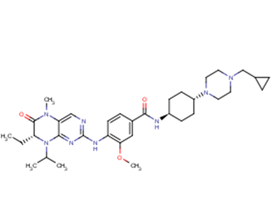Powder: -20°C for 3 years | In solvent: -80°C for 1 year


Volasertib (BI 6727) (BI-6727) is a potent inhibitor of PLK1 (IC50: 0.87 nM), inducing mitotic arrest and apoptosis. It also inhibits PLK2/PLK3 (IC50s: 5/56 nM).

| Pack Size | Availability | Price/USD | Quantity |
|---|---|---|---|
| 1 mg | In stock | $ 39.00 | |
| 2 mg | In stock | $ 56.00 | |
| 5 mg | In stock | $ 93.00 | |
| 10 mg | In stock | $ 165.00 | |
| 25 mg | In stock | $ 290.00 | |
| 50 mg | In stock | $ 523.00 | |
| 100 mg | In stock | $ 759.00 | |
| 500 mg | In stock | $ 1,580.00 | |
| 1 mL * 10 mM (in DMSO) | In stock | $ 128.00 |




| Description | Volasertib (BI 6727) (BI-6727) is a potent inhibitor of PLK1 (IC50: 0.87 nM), inducing mitotic arrest and apoptosis. It also inhibits PLK2/PLK3 (IC50s: 5/56 nM). |
| Targets&IC50 | PLK3:56 nM (cell free), PLK1:0.87 nM (cell free), PLK2:5 nM (cell free) |
| In vitro | Volasertib (BI 6727) potently inhibited Plk1 as well as the two closely related kinases Plk2 and Plk3 (IC50 values 0.87, 5, and 56 nmol/L, respectively). BI 6727 inhibited proliferation of multiple cell lines derived from various cancer tissues, including carcinomas of the colon (HCT 116, EC50 = 23 nmol/L) and lung (NCI-H460, EC50 = 21 nmol/L), melanoma (BRO, EC50 = 11 nmol/L), and hematopoietic cancers (GRANTA-519, EC50 = 15 nmol/L; HL-60, EC50 = 32 nmol/L) with EC50 values of 11 to 37 nmol/L [1]. BI 6727 showed nanomolar activity on NB TICs, with an EC50 of 21 nmol/L, and an excellent selectivity profile, with an EC50 of 2.8 μmol/L on SKPs [2]. Volasertib inhibited proliferation in all 40 cell lines tested, with a mean half-maximal growth inhibitory concentration of 313 nmol/l (range: 4-5000 nmol/l) [3]. |
| In vivo | BI 6727 has physicochemical and pharmacokinetic properties that allow in vivo testing of i.v. as well as oral formulations, adding flexibility to dosing schedules. Finally, BI 6727 shows marked antitumor activity in multiple cancer models, including a model of taxane-resistant colorectal cancer [1]. Volasertib was highly active against RMS-1 alveolar rhabdomyosarcoma xenografts, resulting in 100% tumor regression. Activity was associated with complete and prolonged G2/M arrest and subsequent apoptotic cell death. Volasertib showed synergistic activity with vincristine but antagonistic effects with etoposide [3]. |
| Kinase Assay | Recombinant human Plk1 (residues 1-603) was expressed as NH2-terminal, GST-tagged fusion protein using a baculoviral expression system and purified by affinity chromatography using glutathione-agarose. Enzyme activity assays for Plk1, Plk2, and Plk3 were done in the presence of serially diluted inhibitor using 20 ng of recombinant kinase and 10 μg casein from bovine milk as substrate. Kinase reactions were done in a final volume of 60 μL for 45 min at 30°C [15 mmol/L MgCl2, 25 mmol/L MOPS (pH 7.0), 1 mmol/L DTT, 1% DMSO, 7.5 μmol/L ATP, 0.3 μCi γ-32P-ATP]. Reactions were terminated by the addition of 125 μL of ice-cold 5% TCA. After transferring the precipitates to MultiScreen mixed ester cellulose filter plates, plates were washed with 1% TCA and quantified radiometrically. Dose-response curves were used for calculating IC50 values. To establish a kinase selectivity profile, additional kinase assays were done by contract research organizations or reagents were purchased from commercial sources and assays were done according to the supplier's instructions. Appropriate positive and negative controls were included in the assay design [1]. |
| Cell Research | Cell proliferation assays were done by incubating cells in the presence of various concentrations of BI 6727 for 72 h and cell growth was assessed by measuring Alamar blue dye conversion in a fluorescence spectrophotometer. Effective concentrations at which cellular growth was inhibited by 50% (EC50) were extrapolated from the dose-response curve fit [1]. |
| Animal Research | Female BomTac:NMRI-Foxn1nu mice were grafted s.c. with 2 × 10^6 HCT 116 human colon carcinoma cells (ATCC CCL-247), 1 × 10^6 NCI-H460 non–small cell lung cancer cells (ATCC HTB-177), or CXB1 human colon carcinoma tumor pieces derived from patient material by serial transplantation in nude mice. When tumors had reached a volume of ~50 to 100 mm^3, animals were randomized into treatment and control groups of 10 mice each. BI 6727 was formulated in hydrochloric acid (0.1 N), diluted with 0.9% NaCl, and injected i.v. into the tail vein at the indicated dose and schedule. For oral treatment, BI 6727 was resuspended in 0.5% Natrosol 250 hydroxyethyl-cellulose and given intragastrally via gavage needle. An administration volume of 10 mL per kilogram of body weight was used for both administration routes. Tumor volumes were determined thrice a week using a caliper. The results were converted to tumor volume (mm^3) by the formula length × width2 × π/6. The weight of the mice was determined as an indicator of tolerability on the same days. Median tumor volumes on the last day of the experiment were used to calculate treated versus control values (= tumor volume treated mice × 100/tumor volume control mice) [1]. |
| Synonyms | BI 6727 |
| Molecular Weight | 618.81 |
| Formula | C34H50N8O3 |
| CAS No. | 755038-65-4 |
Powder: -20°C for 3 years | In solvent: -80°C for 1 year
H2O: < 1 mg/mL (insoluble or slightly soluble)
DMSO: 16 mg/mL (25.9 mM)
Ethanol: < 1 mg/mL (insoluble or slightly soluble)
You can also refer to dose conversion for different animals. More
bottom
Please see Inhibitor Handling Instructions for more frequently ask questions. Topics include: how to prepare stock solutions, how to store products, and cautions on cell-based assays & animal experiments, etc.
Volasertib 755038-65-4 Apoptosis Cell Cycle/Checkpoint PLK GRANTA-519 Raji BRO Inhibitor ATP-competitive mitotic HL-60 BI-6727 orally BI 6727 Polo-like Kinase (PLK) HCT 116 arrest NCI-H460 inhibit BI6727 dihydropteridinone THP-1 inhibitor
